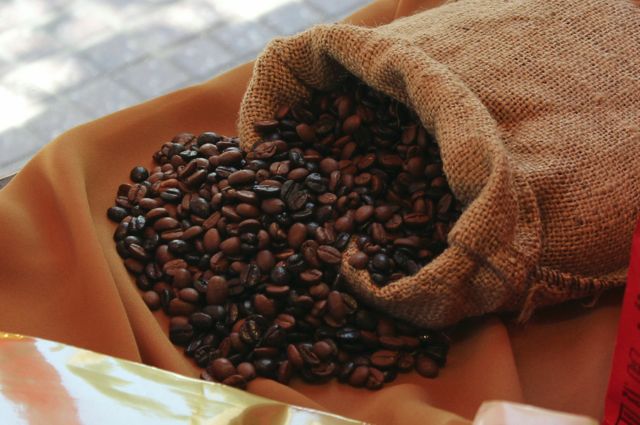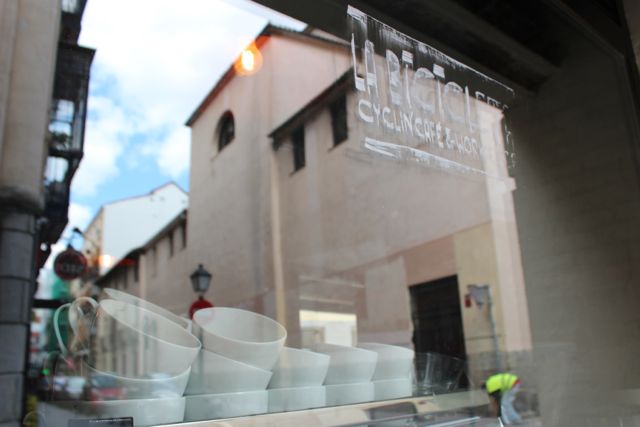The Curious Case of Spanish Coffee (aka “What’s torrefacto?”)
May 22, 2013
TOMA CAFÉ IS ONE OF THE FEW TORREFACTO-FREE ZONES IN THE CITY. THIS IS CO-OWNER SANTI HIGH ON CAFFEINE.
I love the sound of Spanish coffee. The smack and clack of cups and saucers on marble bar tops, the scream of the milk steamer. Prop up a Spanish bar mid-morning and you’re surrounded by a cosy, comforting racket.
But when the black stuff hits my lips, the romance is over. Sipping a café solo in Spain is often like swilling hot, black acid. Bitter, harsh and acrid, with hints of paint thinner.
Blame it on torrefacto!
I first spied the word on the side of supermarket coffee packs when I moved to Spain a couple of years back. “Mezcla. 50% natural. 50% torrefacto.” I had no idea what “torrefacto” was and, when someone mentioned it had something to do with roasted sugar, I shrugged and took another sip.
Then, six months ago, I got talking to a guy at Cafés Pozo. And he mentioned “torrefacto” and “post-civil war Spain” in the same gasp.
I was intrigued.
Plus, I’d started to suspect a link between torrefacto and the fact that the local coffee was stripping my oesophagus.
So I went to Toma Café to find out more. It’s a new(ish) café in Malasaña that’s been getting good press for the quality of its coffee.
“I’ve come to talk torrefacto,” I said to the barista.
“But we don’t serve torrefacto.”
“Exactly.”
Santi and Patricia opened the rustic, pocket-sized (soon to be enlarged) coffee house last year. Surrounded by young, ristretto-toting coffee refugees, who’ve come in search of a decent cup, we perched on coffee sacks and talked about torrefacto.
What the hell is torrefacto?

MEZCLA COFFEE BEANS – A MIX OF TORREFACTO BEANS (THE JET BLACK ONES) AND NATURAL BEANS (THE BROWN ONES).
“Torrefacto is the practice of adding sugar to coffee beans during the roasting process,” explained Patricia. The sugar burns and the beans wind up coated in a shiny black film.
This glossy coating protects the beans from oxidisation and torrefacto was originally a preservation method.
But there are side effects. The process makes the resulting drink much darker and more bitter. It also masks the true, rich flavour and aroma of good coffee.
According to the guys at Toma, stock-standard Madrid bars usually serve a 70/30 or 80/20 mix (where the smaller percentage is torrefacto beans and the rest natural beans). The run-of-the-mill stuff at your supermarket is generally a nipple-hardening 50/50.
But why?
Where does Spain’s torrefacto traditional come from? And what’s it got to do with the Spanish civil war?
Spain’s first torrefactor was José Gómez Tejedor, founder of still-running coffee conglomerate Cafés La Estrella. On a coffee-sourcing trip to Mexico in the early 20th century, José noticed local miners roasting their coffee beans with sugar. The technique stopped the miners’ beans from going off during the long stretches spent underground.
José realised the Mexican miners’ trick was a boon for business back home, allowing him to distribute his coffee more widely throughout Spain without it going bad.

AN ADVERTISEMENT FOR LA ESTRELLA TORREFACTO COFFEE IN THE MADRID METRO.
But torrefacto really took off after the 1936 – 1939 Spanish civil war. The post-war years were marked by scarcity, and coffee was often substituted for chicory and other dodgy, ersatz infusions. Torrefacto became an excellent way of dealing with the coffee shortage. Adding sugar to the roast extended the coffee (because a portion of the coffee that companies were selling was actually sugar), masked the quality of the coffee (allowing companies to use cheaper coffee beans, or other ingredients entirely) and gave the impression of a strong, black cup (allowing companies to use less coffee without the consumer noticing).
In other words, torrefacto helped hard-pressed post-war Spanish coffee companies get by with less and lower-quality beans.
Which all makes sense in the context of 1940s Spain. But why are we still drinking torrefacto in 2013?
According to Magdalena at Infusionistas.com, what was once a post-war necessity, simply became a habit. In other words, Spanish consumers got used to the torrefacto taste.
And Santi and Patricia suggest it’s not in the interests of big Spanish coffee companies to change to 100% good-quality, natural beans. Torrefacto remains an excellent way of bulking up coffee, thereby lowering coffee companies’ costs. (Santiago: “It’s a scam. You’re buying sugar at the price of coffee.”).
But wait, there’s more. A parallel issue affecting the quality of Spanish coffee is that much of it (especially the stuff on sale in the supermarket) contains cheaper, lower-quality and more astringent robusta beans, rather than pricier and richer-tasting arabica beans. So, yes you can buy non-torrefacto in your local supermarket (look for ‘100% natural’), but chances are it’s probably cut-rate robusta (or a fair portion thereof).
I emailed Marcilla, which supplies about 25% of the Spanish market, and asked whether their coffee was robusta or arabica (or what was the mix). They replied that under current Spanish coffee labelling laws, they’re not required to tell me.

LA BICICLETA IS ANOTHER MADRID CAFÉ WHERE TORREFACTO IS SHOT ON SIGHT.
Let them drink torrefacto!
But locals aren’t the only ones with a taste for the gut-busting torrefacto blend. A number of non-Spaniards haven gone online to wax lyrical about torrefacto. This Australian man is “drooling over the idea of torrefacto coffee” and is planning to start roasting his own downunder. And this Englishman calls torrefacto “the essence of heaven”.
To feed this market, online Spanish food shops sell blended torrefacto coffee as a gourmet product. Tienda.com hails the “dusting of a fine sugar mist” added to the beans, as if it were the fruit of gastronomic insight, rather than a technique used by early 20th century miners to stop their coffee going rancid.
So what if I like torrefacto? It’s not like it’s killing me!
Taste is subjective and each to their own. How about health, then? This is where things get murky. Is torrefacto good for you, or is it a little bit lethal?
A 2008 study by Dr. Isabel López Galilea, a scientist at the University of Navarra, claims that torrefacto-roasted coffee has up to twenty times more antioxidants than normal roasted coffee. Yet, at the same time, a few local coffee gurus told me torrefacto causes chaos in the gut and can even accelerate the big C.
I dug around but didn’t find any evidence of torrefacto being directly linked to cancer.
However, I did talk to a pair of nutritionists (Pilar Munné and Júlia Farré). And the upshot was that (as we know) burnt food can upset the stomach and is considered a carcinogen. And given torrefacto is burnt sugar, well… you get the idea. Nothing Earth-shattering, but something to keep in mind.
Life’s too long to drink crap coffee

LA BICICLETA… AGAIN.
So, where does that leave things? Depending on who you are and what you believe, torrefacto is either wonderful or revolting and it’s either the fountain of youth or is killing you softly.
But if you do decide to do your taste buds a favour and ditch the burnt-sugar brew, then pull up a hessian cushion at Toma. Santi and Patricia tell me there’s a coffee renaissance underway in the Spanish capital.
Toma Café
Calle Palma, 49, 28004
tomacafe.es
91 702 56 20
Toma also sells ground coffee and whole beans to go. And below are another couple of Madrid cafés serving 100% natural arabica coffee.
La Bicicleta
Plaza de San Ildefonso, 8, 28004
www.labicicletacafe.com
91 532 97 42
MÜR Cafe
Plaza de Cristino Marcos, 2, 28015
murcafe.es
91 139 98 09
A few shops in Madrid where you can buy decent arabica to drink at home are:
Cafés Pozo
www.cafespozo.es
Cafés La Mexicana
www.lamexicana.es/tiendas
And if you want some tips on how to order coffee in Spain, check out the video below!
James Blick

